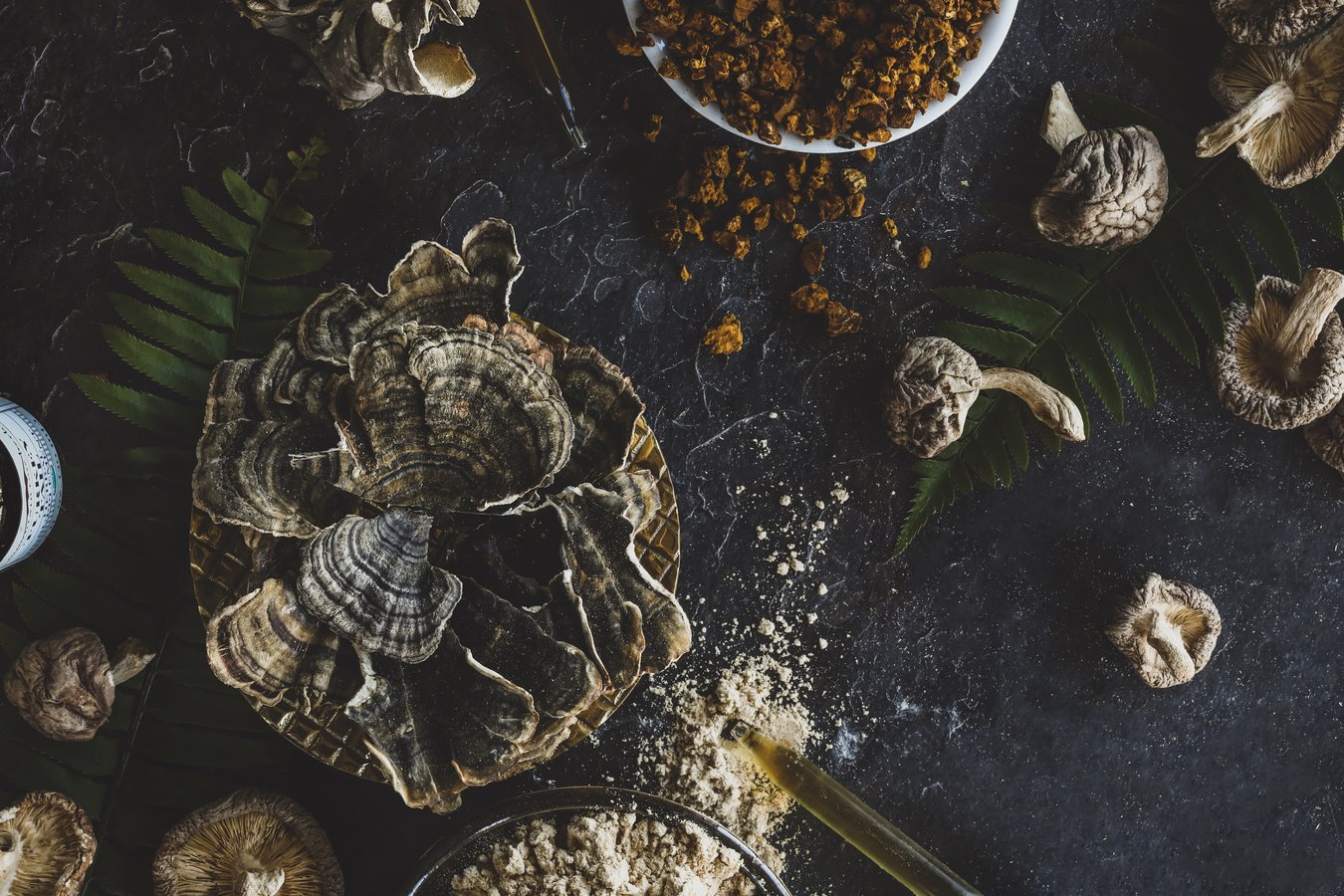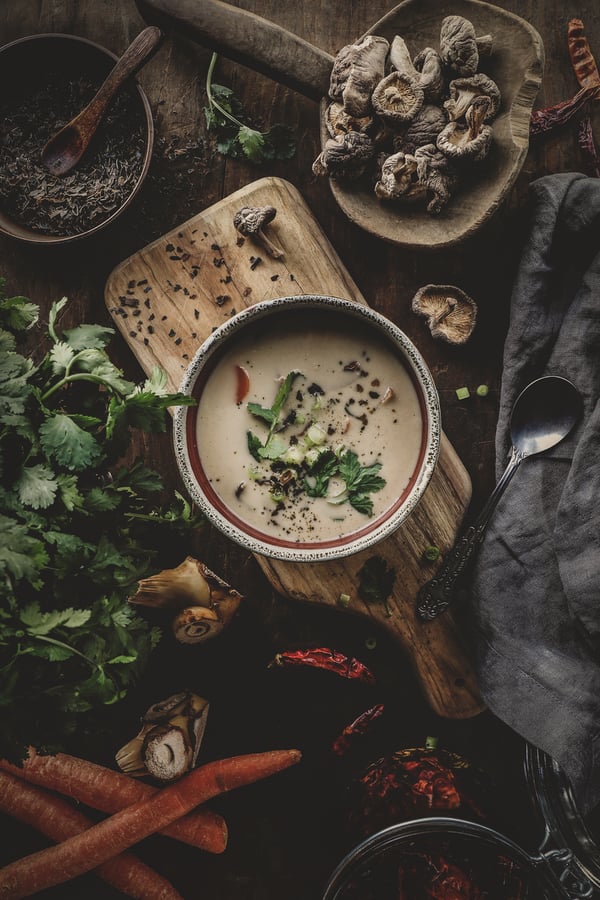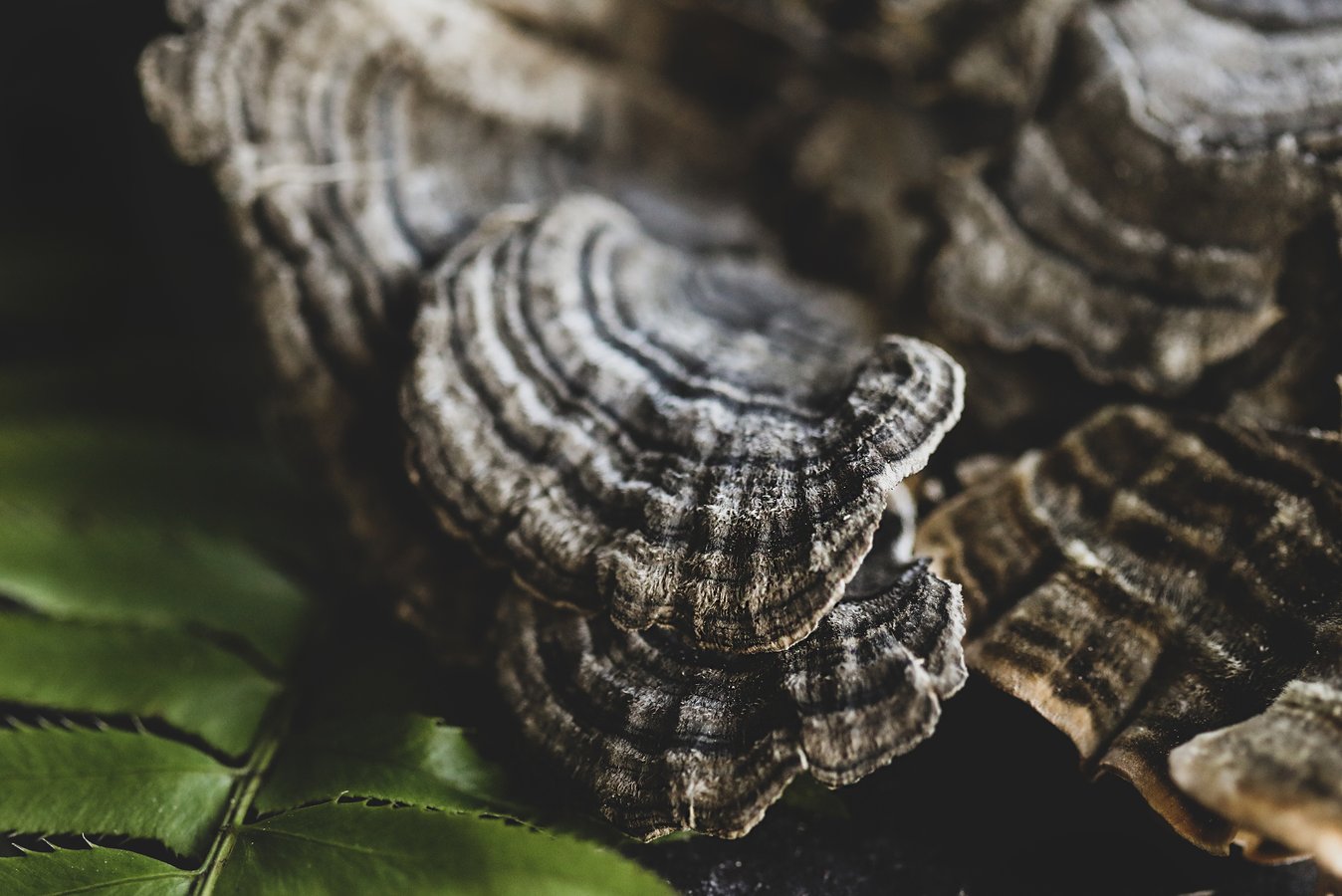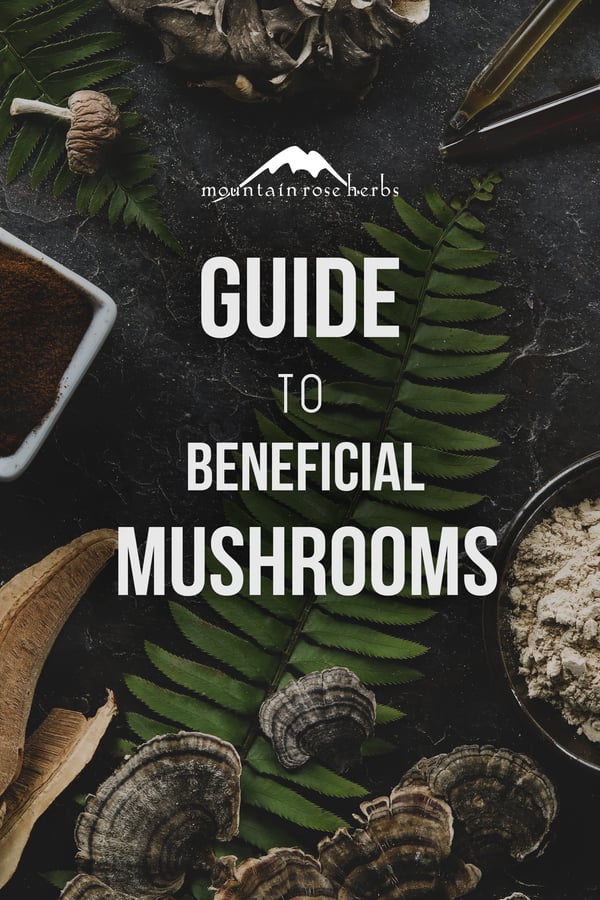In herbalism, herb is the root word. Of course, herbalism encompasses much more than herbs such as basil or rosemary. It also includes tree barks, roots, seeds, and even non-plant life such as mushrooms. I know some herbalist friends who are downright repulsed by mushrooms, but there’s another type of herbalist who is entranced and enamored with these fungal friends. I happen to be one of those weirdos. While I'm not a mycologist, I’ve always enjoyed learning about and including mushrooms in my diet and herbal lifestyle because of their health benefits, lore, and mystery. Science confirms that there are a great many benefits to consuming mushrooms. Let’s explore a few of these mushroom allies.
Chaga (Inonotus obliquus)
Even though our Chaga is certified organic, it is, for all intents and purposes, a wild-harvested mushroom. Unlike oyster mushrooms, shiitake mushrooms, and others, chaga cannot be grown in a conventional sense. Perhaps its wild nature is part of the appeal of this mushroom. We get ours from the forests of northeastern Canada, where it grows primarily on wounded birch trees.
Even more appealing, I’d estimate, are chaga’s touted health benefits, of which there are many. Without sounding too grandiose or making too many claims, here are but a few of the health benefits of this fascinating mushroom. The antioxidant activity of polysaccharides (beta-glucans) contained in chaga mushrooms supports the maintenance of cell integrity, resistance to free radicals, and the body’s immune defenses*. In traditional Russian Folk Medicine and Traditional Chinese Medicine, chaga is used to support gastrointestinal health, and as a tonic for overall health.*
In addition to the health benefits, I must say it’s actually a rather tasty mushroom, especially in tea (or rather, decoction) form. It contains vanillin, which is also found in the vanilla bean. The decoction of chaga mushroom has a silky-smooth flavor, without detectible bitterness, at least to my taste buds. So, compliance in consuming this mushroom consistently should be a non-issue, if taste is the deciding factor.
Another thing to note before moving on to the next mushroom: we take great pride in the ethical wildharvesting of our chaga. For more information on the land where we acquire this species of mushroom, I recommend you read our blog post on our adventure to the Canadian birch forests.
How to Prepare Chaga Mushrooms
As I mentioned, chaga has a fairly pleasant flavor, so making a chaga decoction is a wonderful way to get the benefits of this mushroom. Simply simmer about a cup of the chopped up mushroom pieces in a quart of water for a couple of hours and strain. You can even save the mushroom and make another decoction from it the next day as it’ll still have some of the beneficial constituents in it.
You can also try my recipe for chaga-infused maple syrup, or for convenience sake, make a mushroom double extraction.
Cordyceps (Cordyceps militaris)
In all honesty, I haven’t personally taken cordyceps a whole lot over the years. Mainly because I’ve been much more drawn to other fungi. But if it strikes your fancy, try it, and see how it makes you feel! As I mentioned earlier, some of my friends aren’t too fond of mushrooms. I don’t get it, but if there was a mushroom that helped me understand their point of view, it’d be cordyceps. Technically, cordyceps isn’t a mushroom, but it is a fungus. I’ve heard it called zombie fungus. That fact probably doesn’t help change my friends’ minds, though. I digress…
Get this: the wild cordyceps fungus parasitizes insects, famously caterpillars and ants. Basically, that means the fungus comes into contact with the insect, infects it, spreads throughout the host’s body, and then takes it over. It’s known to control the host’s mind in order to proliferate. Although fascinating, it’s outside of the scope of this blog post. I recommend researching it more though, since it’s pretty neat, if you ask me.
There are over 400 species of cordyceps; Mountain Rose Herbs carries Cordyceps militaris. With ours, no insects have been harmed. The powder is milled from a mycelial biomass that is cultivated on organic oats. The wild form of this species is extremely rare, thus expensive. Our strain is isolated from the wild form and organically grown in the United States.
People include cordyceps in their wellness practice because it supports immune health and the body’s defenses to help you feel your best.* It has long been used traditionally in Tibetan medicine as a tonic to improve energy and endurance.
How to Prepare Cordyceps Mushrooms
Since cordyceps comes in a powder form, I think the easiest way to consume it is mixing it into a smoothie. But, if you’ve got some time on your hands, you can go ahead and make some herbal capsules with them. I've also made chocolates with cordyceps!
Maitake (Grifola frondosa)
Here’s a fun fact: The Japanese name “maitake” translates in English to "dancing mushroom". Apparently, back in the day when people found the maitake, they would dance in celebration because they knew how valuable it was. These days it’s organically grown and widely available, thus much more affordable (supply and demand), but don’t let that stop you from dancing. It’s health benefits alone are worth feeling great about. Maitake contains vitamin D and is also a general support for the immune system.* Maitake mushroom is used in Traditional Chinese Medicine and traditional Japanese herbalism for its health benefits.
How to Prepare Maitake Mushrooms
Maitake is a delicious culinary mushroom, so I prefer using it as a food. It makes a wonderful addition to a hearty soup, and you can make a simple mushroom broth with it as well. All you need to do is simmer maitake mushrooms and vegetable scraps in water for several hours. The proportions of vegetables and mushrooms to water is entirely up to you! I use vegetable scraps that I store in the freezer, and about a handful of maitake mushrooms. But play around with it and adjust according to your taste. I make all of my broths in a crockpot and let them simmer for 24 – 36 hours. Just add salt and you have a delicious mushroom broth! Of course, you can make a double extraction with maitake as well. If you want the benefits but don’t have the time to make an extract, we do offer it on our website.
Reishi (Ganoderma lucidum)
The reishi mushroom is one of the most highly prized herbs in Traditional Chinese Medicine (TCM). In TCM reishi is called lingzhi, which translates to “mushroom of immortality”. Now, that’s most definitely a bit of a stretch, but given the name, you can see that it’s in the upper echelon of the TCM herbal system.
Ganoderma lucidum is a polypore mushroom. Poly means many, and pore means pore, which is basically just a tiny opening on the surface where things can pass through. If you’ve ever walked through the woods and seen a mushroom growing horizontally off the side of a dead tree, black-ish on top, white on bottom, it’s possible it’s a Ganoderma genus. Not guaranteed, but possible. Here in Oregon, we have a couple of species of Ganoderma, but the one that’s been most studied for its health benefits is the reishi mushroom, Ganoderma lucidum. This is the one that we carry, and it’s organically grown, not wildharvested. In TCM, reishi is known as a qi tonic. It also supports immune health.*
How to Prepare Reishi Mushrooms
Reishi is probably the mushroom I enjoy the most. My favorite preparation is making a weekly reishi decoction that I combine it with astragalus. As with chaga, this mushroom also goes in the crockpot and simmers for a day. Simply fill the crockpot with water and toss in a handful of reishi mushroom slices. Simmer for 24 hours. Allow the water to cool, remove the reishi slices, and decant into a few quart jars. I like to sip on the bitter reishi brew throughout the week, then start all over. When I make my regular culinary broths, I’ve also been known to throw in a reishi slice just to enhance the health benefits. One slice does the trick without making the broth detectably bitter. As with all the mushrooms, a double extraction is also a solid route to take (or you can purchase one premade).
The shiitake is one of the more popular organically grown mushrooms and is a choice edible. Sure, it’s also a boon to the immune system like the other mushrooms, but it has myriad other health benefits as well. It is known to support cardiovascular health and contains polysaccharides (beta-glucans) which help maintain cell integrity and resistance to free radicals.* Despite its nutrition profile, one of the best reasons to consume the shiitake is that it’s just plain delicious.
How to Prepare Shiitake Mushrooms
You probably guessed it; shiitake is best consumed as a food. Shiitake goes wonderfully in my tom kha soup recipe, or simply stir-fried with veggies.
Turkey tail (Trametes versicolor)
Like reishi, turkey tail is another polypore mushroom. I find it to be an absolutely gorgeous mushroom. Every time I walk by one, I find myself snapping pictures of it and sharing it on my Instagram story. Turkey tail is triangular, and roundish, and the top of it is kind of velvety. It’s striped, rotating between red, brown, and grey lines. Like I said, I find it stunning. Aptly named, the species is versicolor, which means “several colors”.
Now, before you go wildharvesting these in town off rotting tree stumps, know that there are indeed lookalikes (as with most of these mushrooms), so you want to be sure you are absolutely 100% certain what mushroom it is. If you're not quite sure how to harvest your own, you can rest assured with our new organically grown turkey tail mushroom. I was thrilled when we started carrying it!
Turkey tail has been extensively studied for its health benefits over the years. This is probably because it is widespread throughout the world and is used in many of the world’s traditions of herbalism. For instance, in the TCM system, it is used to support the liver and the immune system.* As with most of these mushrooms, a lot of the mushroom’s benefits come from its beta-glucans (a form of soluble fiber).
How to Prepare Turkey Tail Mushrooms
Easily my favorite way to take turkey tail is by making a double-extraction. This way I know I’m getting all of the beneficial constituents from the hot water extraction and am pulling them out through the alcohol extraction. It’s a very convenient way to take this mushroom. If you prefer a pre-made mushroom supplement, we do make our own turkey tail tincture in-house.
As I mentioned in the intro, I’m not a mushroom expert. Just an enthusiastic fan, excited about the health benefits they bring to me and my family, as well as the general wonder they produce. This blog’s intent is purely to give you a brief intro to some of my favorite fungal allies, and a full scope of our beneficial mushrooms. If one of these mushrooms speaks to you, I highly recommend researching it more and integrating it into your life as much as possible. Shoot, I’ve even seen my co-workers include mushrooms into their potpourri and wreaths!
For further reading, I recommend Christopher Hobb’s classic book “Medicinal Mushrooms”. You also can’t go wrong with any of Paul Stamet’s plethora of books. And I’d be remiss if I didn’t mention everyone’s favorite “All that the Rain Promises and More” by David Arora.
Let us know in the comments below how you include mushrooms into your daily life!
For more mushroom fun, enjoy this video with the one and only Rosemary Gladstar.
Want more mushroom inspo?
3 Easy Shiitake Mushroom Recipes
You may also be interested in:
- Homemade Vegan Pho with Mushrooms
- Roasted Brussels Sprouts with Shiitake Mushrooms
- Reishi Mushroom Chai for Immune Support
*These statements have not been evaluated by the Food and Drug Administration. This product is not intended to diagnose, treat, cure, or prevent any disease. For educational purposes only
















